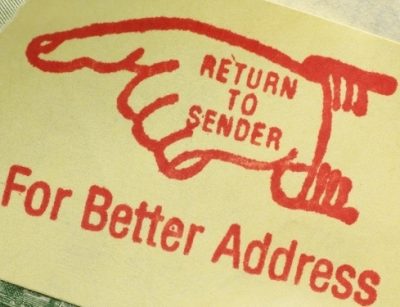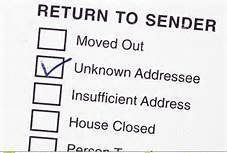So…
you probably wouldn’t be surprised to find out that every now and then we find there’s an addressing issues with one of the orders we receive, and while we don’t really enjoy playing detective to correct mistakes in addressing, we understand that its just something we just have to deal with every now and then. But you know what? The number of addressing issues we’ve had to deal with seems to have increased geometrically in the past few months.
“What’s the big deal?”, you might ask…
It’s simple really…. Any amount of time we spend calling, emailing and otherwise trying to solve these addressing issues, (besides being annoying), is time we’re NOT SPENDING in the studio doing things that actually help our business.
So… below is a list (in no particular order) of the addressing issues we are seeing on an ever-increasing basis, but I have no idea why we’re seeing more and more of this!
No Last Name– How does this happen? It’s most likely because website has a slightly different address form. Some call for your complete name to be typed on one line, but others want your first and last name on separate lines. Additionally, many folks utilize an “auto-fill” function which allows your complete to fill-in the blanks for you, (but since computers have no brain, they sometimes fill-in the form incorrectly). Either way, this address issue is one that can easily be avoided by simply checking the form before submitting the order. I can probably get away with addressing a shipment to a last name only if I have to. I could always address it to Ms. Whomever, however, if I send an envelope off addressed only to Julia or Mandy, there’s a really good chance that somewhere along the way it’s going to get waylaid or ultimately returned to us.
An incomplete address– This typically involves an omission of one or more key elements, such as a postal code or even a state. Our postal software can usually generate a correct U.S. zip code for us, but leaving out the state is a bigger problem that generally requires us getting in touch with the customer.
A mis-typed address– This can potentially be a much bigger problem than either of the above because in many instances, we’ll have no idea that there is a problem. For example, if a customer mistypes their house number and as it turns out that house number doesn’t exist, then our mailing software will usually catch it. We’ll still have to track down this customer to get the correct info, but at least we won’t send our package out to the wrong house which is exactly what happens if the mistyped house number actually DOES exist. Sometimes our package comes back to us but many times it’s just GONE. The result either way is a significant delay for an aggravated customer, not to mention a loss for us.
Providing a address that has known problems– I’ve got to say that I have big problems with this particular excuse! And believe it or not, this has happened to us THREE times in the last 6 months. It goes like this…. we send out the package to the address provided by the customer, but 2-3 three weeks later we get a phone call complaining that they never received their order. So we send a 2nd parcel out to the same address but lo and behold, a week or so later the original order is returned to us (because there is NO SUCH ADDRESS). Now we know the 2nd order may be getting returned to us as well (or not, as the case may be). When I relay this info to the customer in question we hear something to this effect, “yeah, we’ve been having problems with our address.” …………. And yet they keep on using it! Grrrrrr
Unidentified abbreviations– So… if you were given this address, 262 W Third St. #201, would you know if the #201 referred to an apartment #, a suite #, a space #, a PO Box # or something else? How can we know? And while sometimes the parcel gets to the customer addressed this way… sometimes it doesn’t. Sometimes our mailing software recognizes the address and adds the missing component, and sometimes it just rejects it. But here’s my question…. does it REALLY take that much more time for this customer to give us the complete address?
Case in point— (and I swear I am NOT making this up!)
Recently I received an order with a record number of addressing errors on it.
1) She spelled her city like this- Hrtlnd… no vowels at all.
2) I tried calling her about this, but she only provided 9 digits for her phone number.
3) and when I emailed her using the address she provided, it bounced back, so I waited a few days and ultimately cancelled the order. What else could I do? There was no way to reach her until….
4) she called us a couple weeks later wanting to know where her order was, it turns out there was yet ANOTHER error in her address. Yep, instead of Catkin Ct., it was supposed to be Carlin Ct.
REALLY????
Which serves to illustrate my main point…. it’s impossible for us to resolve ANY of these issues without getting in touch with a customer either by phone or by email, but sometimes its just not possible to do that. And why would that be?
Because the customer has DELIBERATELY given us erroneous contact info!
Yep, it’s mystifying to me, (and I swear I am NOT making this up), but it’s becoming increasing popular for customers to provide a false phone number to avoid unsolicited phone calls. But since an email address is generally required for an online order, many people now use what’s commonly know as a “dummy email address” when they buy items online. This would be an email address that’s ONLY used for internet ordering, which they likely only check in order to retrieve their receipt, if then.
Their reasoning? To protect themselves from potential identity theft and junkmail. This seems illogical to me because if a customer is willing to trust me with their credit card number, why in the world wouldn’t they trust me with their email address? And if for some reason this bizarre habit makes them feel safer, then they need to understand that there are often very legitimate reasons that an online retailer might need to contact them following a sale. There may be a duplicate in their order, or an item may be out of stock and on back-order). But they’ll never know this if they don’t check their dummy email address on a regular basis.
But here’s the bottom line…
All of this confusion and extra work could be easily avoided if customers would simply take an extra 30-60 seconds to re-examine the items they have ordered for un-wanted duplications (which ALSO occurs all-too-frequently) and proof-read their mailing/contact info…. PLEASE?
**********************************************************************************
And now…. it’s YOUR turn!
Do you have any comments or personal insight to share on this subject? And do you , or do any of your friends make use of a “dummy email address” for online ordering? Remember, we love reading your comments and answering your questions too, so please feel free to leave either in the space provided below.
******************************************************************
Check out the best sewing pins with me on Pinterest, join in on discussions or show off your work in our FaceBook Group, or get your daily sewing fix on our Facebook Business Page or get behind the scenes scoops on Instagram, and be the 1st to know about new patterns, discount codes and sample sales by signing up for our monthly newsletter.









